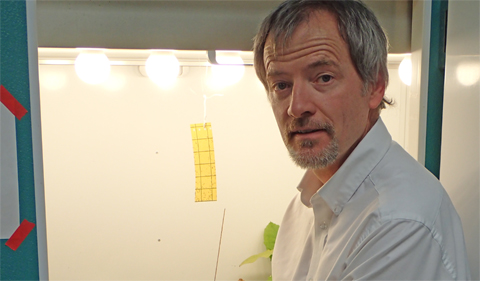
Dr. David Rosenthal measures photosynthetic parameters of American and hybrid chestnuts grown at temperature and CO2 levels predicted for later this century.
Dr. David Rosenthal, Assistant Professor of Environmental & Plant Biology at Ohio University, co-authored an article on “Leaf and canopy scale drivers of genotypic variation in soybean response to elevated carbon dioxide concentration” in Global Change Biology.
Co-authors on the article are Alvaro Sanz-Saez, Robert P. Koester, Christopher M. Montes, Donald R. Ort, and Elizabeth A. Ainsworth of the University of Illinois.
Abstract: The atmospheric [CO2] in which crops grow today is greater than at any point in their domestication history and represents an opportunity for positive effects on seed yield that can counteract the negative effects of greater heat and drought this century. In order to maximize yields under future atmospheric [CO2], we need to identify and study crop cultivars that respond most favorably to elevated [CO2] and understand the mechanisms contributing to their responsiveness. Soybean (Glycine max Merr.) is a widely grown oilseed crop and shows genetic variation in response to elevated [CO2]. However, few studies have studied the physiological basis for this variation. Here, we examined canopy light interception, photosynthesis, respiration and radiation use efficiency along with yield and yield parameters in two cultivars of soybean (Loda and HS93-4118) previously reported to have similar seed yield at ambient [CO2], but contrasting responses to elevated [CO2]. Seed yield increased by 26% at elevated [CO2] (600 μmol/mol) in the responsive cultivar Loda, but only by 11% in HS93-4118. Canopy light interception and leaf area index were greater in HS93-4118 in ambient [CO2], but increased more in response to elevated [CO2] in Loda. Radiation use efficiency and harvest index were also greater in Loda than HS93-4118 at both ambient and elevated [CO2]. Daily C assimilation was greater at elevated [CO2] in both cultivars, while stomatal conductance was lower. Electron transport capacity was also greater in Loda than HS93-4118, but there was no difference in the response of photosynthetic traits to elevated [CO2] in the two cultivars. Overall, this greater understanding of leaf- and canopy-level photosynthetic traits provides a strong conceptual basis for modeling genotypic variation in response to elevated [CO2].



















Comments